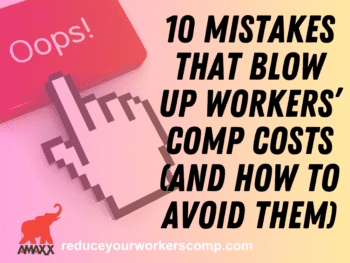Employers, especially small and medium size companies, often are focused on the product or service they provide and inadvertently overlook several areas where they could reduce the cost of workers’ compensation. The following are six workers comp mistakes which cause employers to end up paying too much for workers compensation insurance.
1. Lack of a Formal Safety Program. The number one cause of workers’ compensation premium increases is the frequency of workers’ compensation claims. The more injury claims the employer has, the greater the payout by the insurance company which results in a higher insurance premium. A safety program designed to eliminate the causes of accidents will decrease both the number of injuries and decrease the severity of the injuries that do occur. By installing and following a formal safety program, an employer will reduce the number of workers’ compensation claims. The cost of the safety program will be recovered several times over in the lower cost of workers’ compensation insurance premiums.
2. Selecting the Insurance Company Based on Price. A common mistake of employers is thinking that all insurance companies are the same, and selecting the insurer based on the initial price quote. The quality of service, both from the underwriting department and from the claim department should be taken into consideration. If the insurance company does a lousy job handling the workers’ compensation claims, the cost of the claims will rise, and the underwriting department of the insurer will pass that cost on to the employer in the form of higher premiums in the subsequent years. The employer should investigate the prospective insurer to see what their track record is for handling claims and raising/lowering future premiums.
3. Selecting the Wrong Insurance Broker. The employer should look for a broker who will work with them in a partnership approach to controlling the cost of workers’ compensation. If the broker is just a salesperson who will have no further contact with the employer after the policy is placed, the employer loses out on the services a good insurance broker can provide. A broker should be able to provide resources to the employer including guidance on risk control, safety programs and claims, while acting as a liaison with the insurer when needed.
4. The Attitude that Work Comp is a Cost of Doing Business. Employers who have the attitude that workers’ compensation is a state mandated cost of doing business end up with significantly higher insurance premiums, then the employers who manage their workers’ compensation. While work comp insurance is mandatory in every state, there are many cost saving approaches that can be taken in every state to minimize the cost. The employer who searches for ways to reduce workers’ compensation cost will have lower work comp insurance cost. [For many recommendations on controlling the cost of workers’ compensation, please visit the various articles on our website].
5. Measuring Work Comp by Premiums Paid. When employers think the cost of workers’ compensation is the amount of premium they pay to the insurance company, they overlook the indirect cost which can actually exceed the amount paid in work comp insurance premiums. When an employee is injured there are several areas where indirect cost to the employer begin to increase. This includes:
· lost production or overtime cost to complete the work the injured employee would have completed,
· supervisory time dealing with the injury and injured employee,
· equipment or property damaged by the accident,
· hiring and training cost to replace the employee if the employee does not return to work,
· lower morale among the remaining employees as they see the dangers of the workplace,
· unhappy customers if the injury results in a delay in service or products delivered
6. Forgetting About the Injured Employee. The employer who treats the injured employee like an employee who has quit the company makes an expensive mistake. When an employee is injured, the employer should be in contact with the injured employee on a regular basis, expressing the need and desire for the employee to return to work while expressing empathy for the employee’s injury. The employer should have a light duty job program available for the injured employee until they can return to work full duty. When the employer does not communicate with the injured employee, the employee will find someone who will listen to their needs and concerns. This is usually an attorney who will do whatever the attorney can do to increase the size of the workers’ compensation claim. This is in an effort to increase the amount of money the employee will receive and of course, the amount of money the attorney will receive.
Author Michael B. Stack, CPA, Director of Operations, Amaxx Risk Solutions, Inc. is an expert in employer communication systems and part of the Amaxx team helping companies reduce their workers compensation costs by 20% to 50%. He is a writer, speaker, and website publisher. www.reduceyourworkerscomp.com. Contact: mstack@reduceyourworkerscomp.com.
©2013 Amaxx Risk Solutions, Inc. All rights reserved under International Copyright Law.












